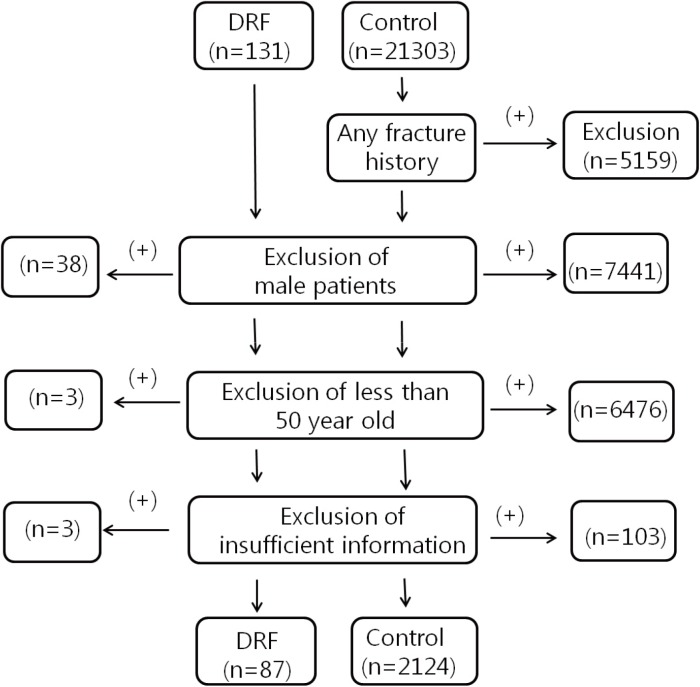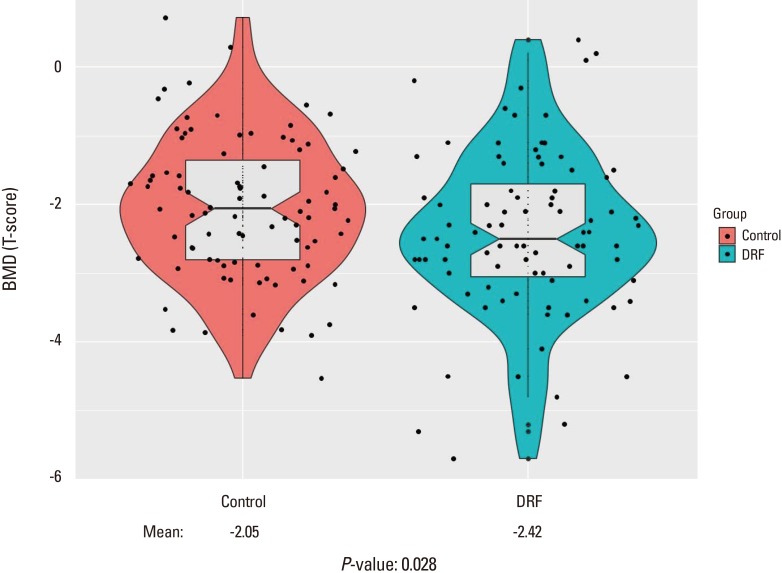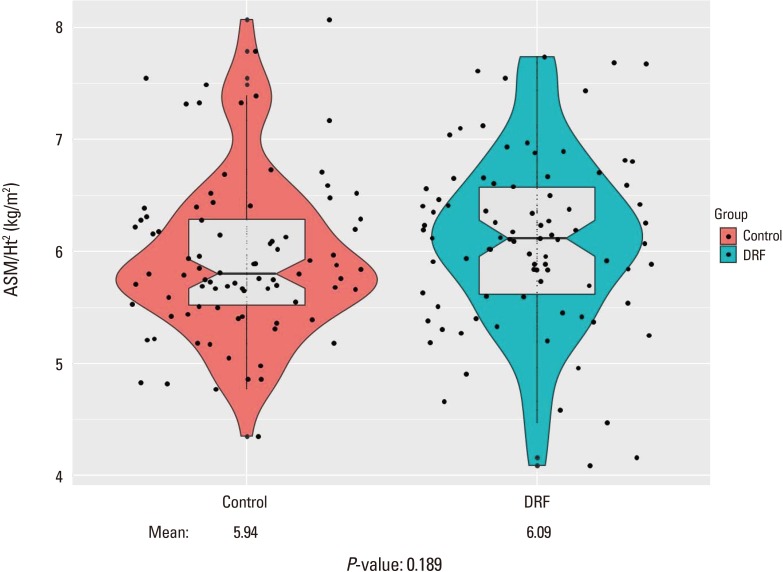J Bone Metab.
2018 May;25(2):99-106. 10.11005/jbm.2018.25.2.99.
Is Sarcopenia a Potential Risk Factor for Distal Radius Fracture? Analysis Using Propensity Score Matching
- Affiliations
-
- 1Department of Orthopaedic Surgery, Seoul Paik Hospital, Inje University College of Medicine, Seoul, Korea.
- 2Department of Orthopaedic Surgery, Bundang CHA Medical Center, CHA University School of Medicine, Seongnam, Korea. hsoohong@hanmail.net
- KMID: 2413371
- DOI: http://doi.org/10.11005/jbm.2018.25.2.99
Abstract
- BACKGROUND
Cases of low-energy-induced distal radius fracture (DRF) are increasing. Sarcopenia is considered to be an independent risk factor for fragility fractures. We compared body appendicular lean muscle mass (ALM) and bone mineral density (BMD) in patients with DRF and a comparable control population. This study aimed to investigate the correlation between skeletal muscle mass and DRF.
METHODS
We performed a retrospective review of patients diagnosed with fragility DRF. The DRF group included 87 patients treated at our institute. The control group comprised data for 87 individuals in the general population from among 2,124 selected using nearest-neighbor propensity scoring, based on age, weight, height, and body mass index. All medical conditions and past history were also compared between the two groups.
RESULTS
The relative overall ALM, combining arm and leg lean body mass divided by height squared, was not significantly different (DRF group, 6.093 kg/m²; controls, 5.945 kg/m²). T-score, a parameter of BMD, was significantly different between groups (DRF, −2.42; controls, −2.05). The proportion of patients with osteoporosis was significantly different (DRF, 44 [50.6%] vs. control, 29 [33.3%], respectively).
CONCLUSIONS
Patients with DRF did not have significantly lower average lean body mass. BMD was significantly lower in patients with DRF than in controls.
MeSH Terms
Figure
Cited by 1 articles
-
Evaluation and Management of Osteoporosis and Sarcopenia in Patients with Distal Radius Fractures
Gajendra Mani Shah, Hyun Sik Gong, Young Ju Chae, Yeun Soo Kim, Jihyeung Kim, Goo Hyun Baek
Clin Orthop Surg. 2020;12(1):9-21. doi: 10.4055/cios.2020.12.1.9.
Reference
-
1. Ruch DS, McQueen MM. Distal radius and ulna fractures. In : Bucholz RW, Court-Brown CM, Heckman JD, editors. Rockwood and Green's fractures in adults. 7th ed. Philadelphia, PA: Lippincott Williams and Wilkins;2010. p. 829–877.2. Wolfe SW. Distal radius fractures. In : Wolfe SW, Hotchkiss RNPWC, Kozin SH, editors. Green's operative hand surgery. 7th ed. Philadelphia, PA: Elsevier;2017. p. 576.3. Rozental TD, Makhni EC, Day CS, et al. Improving evaluation and treatment for osteoporosis following distal radial fractures. A prospective randomized intervention. J Bone Joint Surg Am. 2008; 90:953–961. PMID: 18451385.4. Xu W, Ni C, Yu R, et al. Risk factors for distal radius fracture in postmenopausal women. Orthopade. 2017; 46:447–450. PMID: 28258366.
Article5. Phillips SM. Nutritional supplements in support of resistance exercise to counter age-related sarcopenia. Adv Nutr. 2015; 6:452–460. PMID: 26178029.
Article6. Roh YH, Koh YD, Noh JH, et al. Evaluation of sarcopenia in patients with distal radius fractures. Arch Osteoporos. 2017; 12:5. PMID: 28004299.
Article7. Kelly TL, Wilson KE, Heymsfield SB. Dual energy X-Ray absorptiometry body composition reference values from NHANES. PLoS One. 2009; 4:e7038. PMID: 19753111.
Article8. Yoon BH, Lee JK, Choi DS, et al. Prevalence and associated risk factors of sarcopenia in female patients with osteoporotic fracture. J Bone Metab. 2018; 25:59–62. PMID: 29564307.
Article9. Hind K, Oldroyd B. In-vivo precision of the GE Lunar iDXA densitometer for the measurement of appendicular and trunk lean and fat mass. Eur J Clin Nutr. 2013; 67:1331–1333. PMID: 24169463.
Article10. Heymsfield SB, Smith R, Aulet M, et al. Appendicular skeletal muscle mass: measurement by dual-photon absorptiometry. Am J Clin Nutr. 1990; 52:214–218. PMID: 2375286.
Article11. Kweon S, Kim Y, Jang MJ, et al. Data resource profile: the Korea National Health and Nutrition Examination Survey (KNHANES). Int J Epidemiol. 2014; 43:69–77. PMID: 24585853.
Article12. Sanders KM, Pasco JA, Ugoni AM, et al. The exclusion of high trauma fractures may underestimate the prevalence of bone fragility fractures in the community: the Geelong Osteoporosis Study. J Bone Miner Res. 1998; 13:1337–1342. PMID: 9718203.
Article13. Salminen S, Pihlajamäki H, Avikainen V, et al. Specific features associated with femoral shaft fractures caused by low-energy trauma. J Trauma. 1997; 43:117–122. PMID: 9253920.
Article14. Cruz-Jentoft AJ, Baeyens JP, Bauer JM, et al. Sarcopenia: European consensus on definition and diagnosis: Report of the European Working Group on Sarcopenia in Older People. Age Ageing. 2010; 39:412–423. PMID: 20392703.
Article15. Serra Rexach JA. Clinical consequences of sarcopenia. Nutr Hosp. 2006; 21(Suppl 3):46–50. PMID: 16768030.16. Hirschfeld HP, Kinsella R, Duque G. Osteosarcopenia: where bone, muscle, and fat collide. Osteoporos Int. 2017; 28:2781–2790. PMID: 28733716.
Article17. Kanis JA, Melton LJ 3rd, Christiansen C, et al. The diagnosis of osteoporosis. J Bone Miner Res. 1994; 9:1137–1141. PMID: 7976495.
Article18. Janssen I, Heymsfield SB, Ross R. Low relative skeletal muscle mass (sarcopenia) in older persons is associated with functional impairment and physical disability. J Am Geriatr Soc. 2002; 50:889–896. PMID: 12028177.
Article19. Chen LK, Liu LK, Woo J, et al. Sarcopenia in Asia: consensus report of the Asian Working Group for Sarcopenia. J Am Med Dir Assoc. 2014; 15:95–101. PMID: 24461239.
Article20. Lang T, Cauley JA, Tylavsky F, et al. Computed tomographic measurements of thigh muscle cross-sectional area and attenuation coefficient predict hip fracture: the health, aging, and body composition study. J Bone Miner Res. 2010; 25:513–519. PMID: 20422623.
Article21. Malafarina V, Uriz-Otano F, Iniesta R, et al. Sarcopenia in the elderly: diagnosis, physiopathology and treatment. Maturitas. 2012; 71:109–114. PMID: 22153348.
Article22. Bokshan SL, DePasse JM, Daniels AH. Sarcopenia in orthopedic surgery. Orthopedics. 2016; 39:e295–e300. PMID: 26913764.
Article23. Landi F, Calvani R, Ortolani E, et al. The association between sarcopenia and functional outcomes among older patients with hip fracture undergoing in-hospital rehabilitation. Osteoporos Int. 2017; 28:1569–1576. PMID: 28154941.
Article24. Yoo JI, Ha YC, Kwon HB, et al. High prevalence of sarcopenia in Korean patients after hip fracture: a case-control study. J Korean Med Sci. 2016; 31:1479–1484. PMID: 27510394.
Article25. Genant HK. Universal standardization for dual X-ray absorptiometry: patient and phantom cross-calibration results. J Bone Miner Res. 1995; 10:997–998. PMID: 7572326.
Article26. Fan B, Lu Y, Genant H, et al. Does standardized BMD still remove differences between Hologic and GE-Lunar state-of-the-art DXA systems? Osteoporos Int. 2010; 21:1227–1236. PMID: 19859644.
Article27. Shepherd JA, Fan B, Lu Y, et al. A multinational study to develop universal standardization of whole-body bone density and composition using GE Healthcare Lunar and Hologic DXA systems. J Bone Miner Res. 2012; 27:2208–2216. PMID: 22623101.
Article28. Xu W, Chafi H, Guo B, et al. Quantitative comparison of 2 dual-energy X-ray absorptiometry systems in assessing body composition and bone mineral measurements. J Clin Densitom. 2016; 19:298–304. PMID: 26206525.
Article29. Johnell O, Kanis J. Epidemiology of osteoporotic fractures. Osteoporos Int. 2005; 16(Suppl 2):S3–S7. PMID: 15365697.
Article
- Full Text Links
- Actions
-
Cited
- CITED
-
- Close
- Share
- Similar articles
-
- Rupture of the Extensor Pollicis Longus after Fracture of the Distal end of the Radius: Report of 3 cases
- Complications of Distal Radius Fracture
- Regional Bone Loss as a Risk Factor for Distal Radius Fracture in Women under 60 Years Old
- Adherence of bisphosphonate and decreased risk of clinical vertebral fracture in osteoporotic patients: A propensity score matching analysis
- Arthroscopically Assisted Reduction of Distal Radius Fractures





